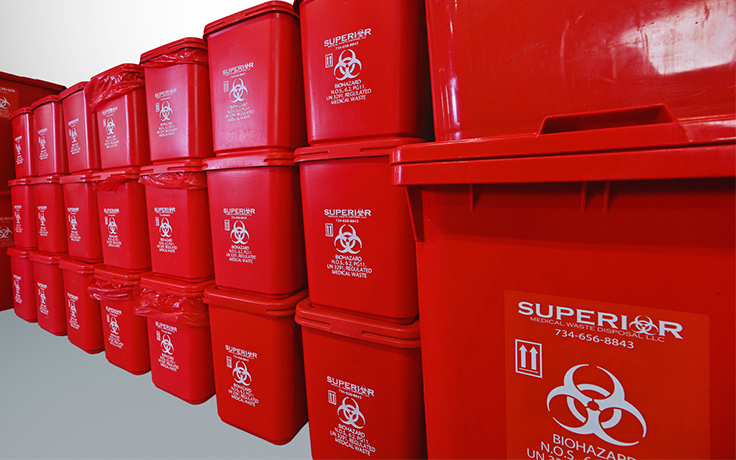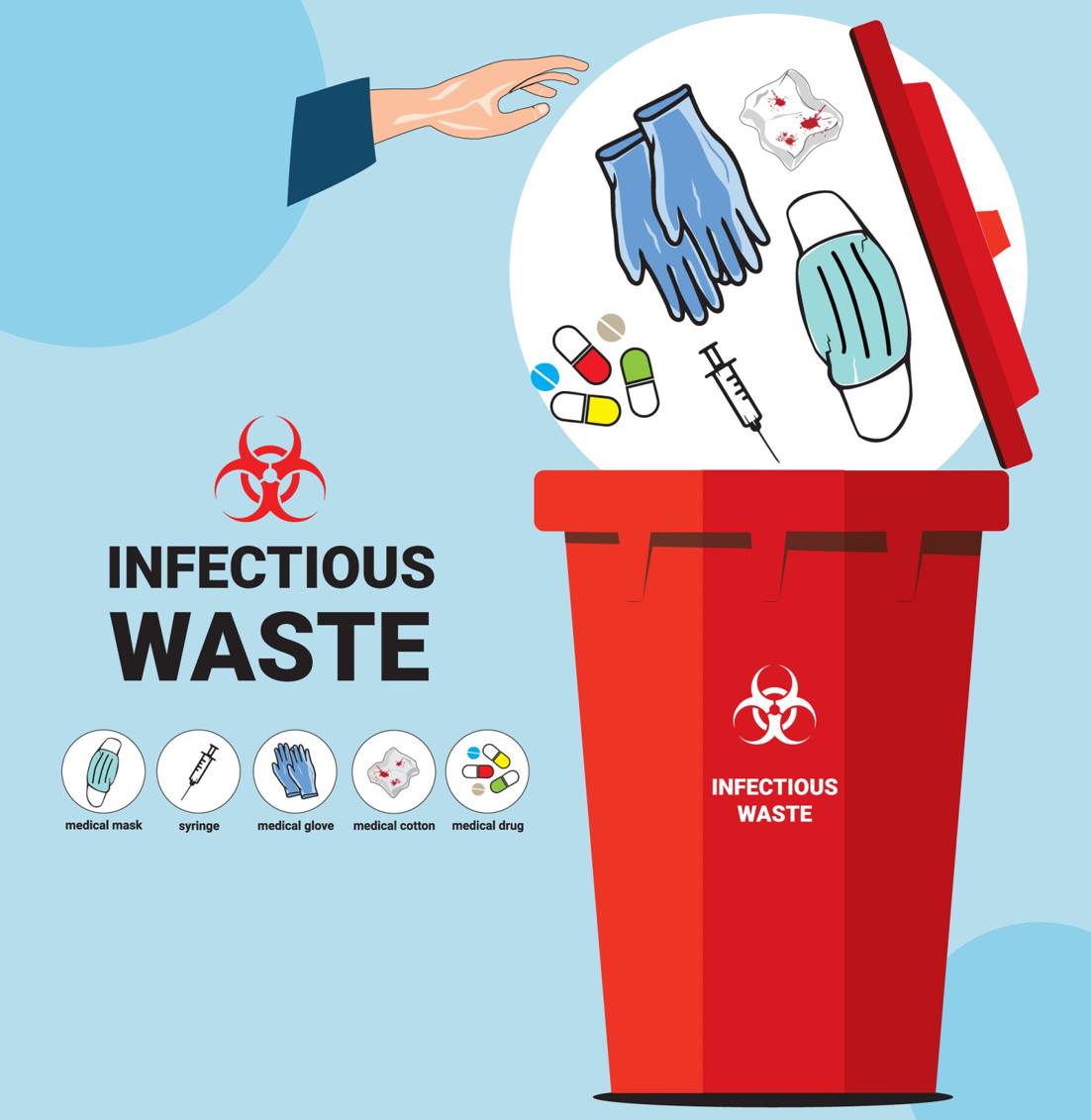Your Ally in Medical Waste Removal: Professional Service with Environmental Care
Wiki Article
Ideal Practices for Medical Waste Management
Medical waste monitoring is a critical facet of medical care facilities' operations to make certain the safety of clients, personnel, and the atmosphere. Applying best practices in clinical waste monitoring is crucial to reduce the dangers linked with dangerous waste.
Partition and Categorization
In the field of medical waste administration, proper partition and categorization are important methods for making certain the safe and effective disposal of healthcare-related materials. Clinical waste is generated from numerous sources, consisting of medical facilities, clinics, laboratories, and various other medical care centers. It consists of a large range of items, such as needles, syringes, bandages, handwear covers, and pharmaceutical waste.Segregation entails the methodical separation of various kinds of medical waste based upon their characteristics and potential threats. This process helps to avoid cross-contamination and ensures that each type of waste is handled appropriately. Sharps waste, such as needles and blades, need to be placed in puncture-resistant containers to avoid injuries and the spread of transmittable diseases. Contagious waste, such as blood-soaked plasters or cultures, need to be set apart and treated separately to minimize the risk of spreading out microorganisms.
Categorization is the procedure of identifying medical waste into various classifications based on its possible risks. These categories may include contagious waste, hazardous waste, pharmaceutical waste, and general waste. By classifying waste, medical care facilities can determine the appropriate disposal techniques and make certain compliance with regional laws and standards.
Proper segregation and categorization of clinical waste not just safeguard the health and wellness of healthcare workers and the basic public but additionally add to the general efficiency and performance of waste monitoring. It minimizes the danger of mishaps, decreases environmental impacts, and advertises accountable waste disposal practices.
Correct Storage Space and Classifying
To make certain the secure and effective disposal of clinical waste, healthcare centers must follow correct storage and labeling methods. WasteX Medical Waste Disposal. Correct storage and labeling play a vital role in maintaining the honesty of clinical waste monitoring systems and securing the health and wellness of health care employees, patients, and the basic publicWhen it pertains to storage space, it is vital to have assigned locations especially designed for various kinds of medical waste. These locations ought to be safe and secure, well-ventilated, and equipped with proper containers that satisfy governing standards (medical waste removal service). Partition and classification of waste need to additionally be thought about to avoid cross-contamination and possible threats

Regular surveillance and examination of storage space locations and containers are vital to identify any type of issues or offenses. Personnel should be educated on proper storage and labeling techniques, highlighting the significance of conformity with policies and procedures.
Safe Transportation and Handling
Making certain the correct and protected transportation and handling of medical waste is crucial for maintaining the integrity of waste monitoring systems and safeguarding the health and wellness of all entailed. Clinical waste, which consists of things contaminated with infectious materials, pharmaceuticals, and various other unsafe compounds, need to be moved in a way that avoids leaks, spills, and prospective contamination.To achieve safe transport and handling, several finest methods need to be adhered to. Initially, it is essential to make use of puncture-resistant and leak-proof containers that are especially designed for medical waste. These containers must be properly sealed and identified to stop any type of unexpected direct exposure or mishandling. Additionally, waste should be set apart based on its nature and type to avoid cross-contamination.
Throughout transport, it is essential to make sure that waste containers are securely secured and stored in a steady manner. Autos utilized for moving clinical waste must be outfitted with suitable safety attributes, such as spill containment systems, to lessen the risk of any kind of leakages or spills. Motorists must get training on proper handling and emergency feedback procedures to efficiently attend to any type of unpredicted events.
In addition, the transportation and handling of medical waste should follow all pertinent laws and guidelines stated by neighborhood, state, and federal authorities. WasteX Medical Waste Disposal. medical waste removal. Routine examinations and audits need to be conducted to examine conformity and identify any type of areas for renovation
Compliance With Regulatory Guidelines
Maintaining compliance with regulatory guidelines is important for reliable clinical waste monitoring. These guidelines are placed in location to safeguard public wellness and the atmosphere by making certain that medical waste is appropriately handled, treated, and disposed of. Compliance with regulatory guidelines aids to prevent the spread of infectious diseases, minimize potential threats, and minimize the total influence of clinical waste on the setting.To achieve conformity, healthcare try this facilities should remain notified concerning the particular policies governing clinical waste administration in their jurisdiction. These laws might vary from country to nation, and also within different states or areas. It is essential for healthcare facilities to have a detailed understanding of these standards and to execute appropriate methods and protocols to guarantee compliance.
One trick facet of conformity is the proper partition and labeling of different kinds of medical waste. This includes dividing sharps from other waste, along with categorizing waste based upon its potential threats. Healthcare facilities should also make certain that clinical waste is saved in ideal containers which these containers are correctly identified and sealed.
Moreover, conformity with regulative standards requires medical care facilities to develop appropriate training and education programs for team member included in clinical waste monitoring. This consists of offering training on waste partition, dealing with, and disposal procedures, along with the correct usage of personal safety tools.
Normal monitoring and audits are also necessary to make sure continuous compliance with governing standards. This involves carrying out normal inspections of waste storage space areas, documenting waste administration treatments, and keeping records of waste disposal.
Reliable Disposal Approaches
Healthcare centers need to employ effective disposal approaches for appropriate administration of medical waste. Inappropriate disposal of medical waste can posture major health and wellness and environmental threats. There are numerous techniques that can be utilized to properly throw away clinical waste, guaranteeing the security of healthcare employees, clients, and the general public.One generally used approach is incineration. Burners can securely melt clinical waste at high temperature levels, minimizing the volume and destroying any type of potentially damaging pathogens. Incineration can be expensive and may launch dangerous toxins into the air if not appropriately regulated.
One more method is autoclaving, which includes subjecting the waste to high-pressure steam. This procedure eliminates bacteria, infections, and various other bacteria, providing the waste safe for disposal in normal waste streams. Autoclaving is a efficient and eco-friendly approach, but it calls for customized equipment and experienced employees.
Chemical disinfection is also made use of sometimes, where fluid chemicals are applied to the waste to decontaminate it. This technique is much less frequently made use of because of concerns regarding the efficiency of chemical disinfection and the capacity for chemical deposits to infect the environment.
In addition to these techniques, medical care facilities need to likewise implement appropriate partition, product packaging, and labeling of clinical waste to guarantee its secure handling and disposal. Normal training and education and learning of team on appropriate waste monitoring methods are critical to keeping effective disposal methods.
Conclusion
In verdict, implementing best methods for medical waste monitoring is vital for guaranteeing the safety and security of health care employees, people, and the setting. By correctly setting apart and categorizing waste, keeping and identifying it properly, ensuring risk-free transportation and handling, following regulative standards, and utilizing reliable disposal approaches, health care facilities can properly take care of and lessen the threats related to medical waste. It is important for healthcare organizations to focus on and adhere to these ideal methods to maintain a secure and sustainable medical care environment.Medical waste monitoring is a crucial facet of medical care facilities' procedures to make certain the security of people, personnel, and the environment. Applying best techniques in medical waste administration is essential to lessen the dangers connected with hazardous waste. These groups might consist of contagious waste, dangerous waste, pharmaceutical waste, and general waste.In conclusion, executing best methods for clinical waste monitoring is important for making sure the safety of healthcare workers, patients, and the atmosphere. By effectively categorizing and segregating waste, storing and identifying it properly, making sure safe transportation and handling, complying with regulative standards, and utilizing reliable disposal techniques, health care centers can properly handle and lessen the risks associated with clinical waste.
Report this wiki page